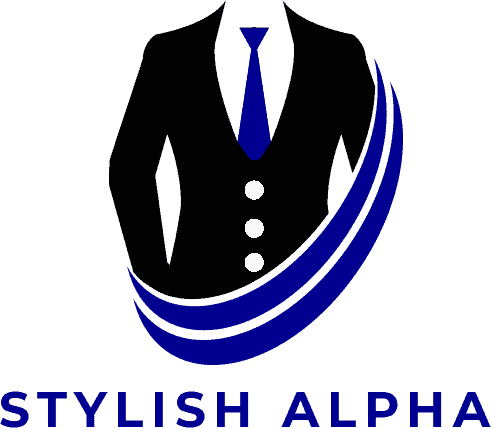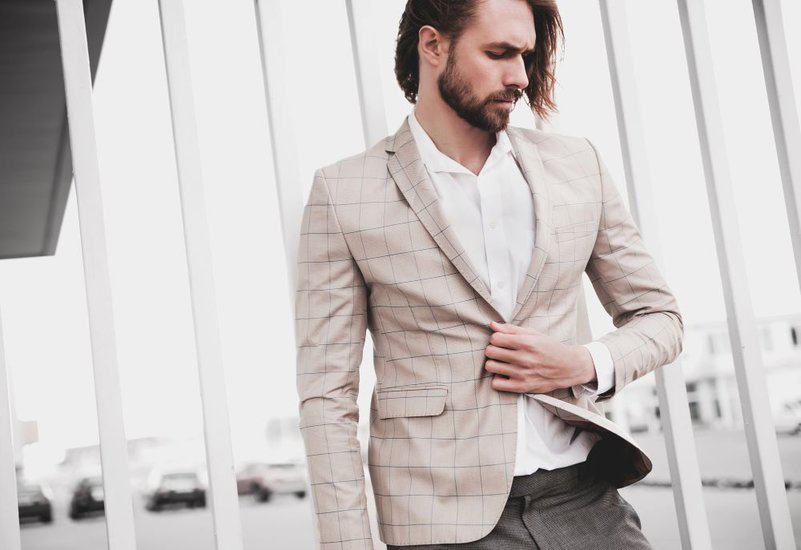I often get asked whether a blazer can effectively double as a casual jacket, and the answer is yes, with some considerations. The versatility of a blazer makes it a staple in my wardrobe, bridging the gap between formal and casual wear with ease.
It’s important to distinguish between a blazer and a suit jacket, though, as they serve distinct purposes and are cut differently. A blazer is designed with more casual styling in mind and can usually be identified by its less structured silhouette and sometimes by different details like contrasting buttons or patch pockets.

When styling a blazer as a jacket, I pay attention to the fabric and fit to ensure that it complements the informality of the occasion. Heavier materials like tweed or fabrics with a texture are more forgiving than the fine wool of a typical suit jacket, allowing a blazer to pair well with jeans or chinos.
By keeping the blazer unbuttoned and pairing it with a relaxed shirt and perhaps even sneakers, I find that I can create a look that speaks to smart-casual with little effort.
My advice for anyone looking to expand their style options is to invest in a well-fitted blazer. The right blazer functions as a multitasker, giving you the freedom to experiment with different looks. Whether I’m heading to a brunch or an informal meeting, my blazer often becomes the centerpiece of my attire, proving that style and versatility can indeed go hand-in-hand.
The Essentials of Blazers and Their Distinction from Suit Jackets
In this section, I’m going to elucidate the defining characteristics of blazers and how they are set apart from suit jackets and sport coats, with a focus on their structure, fabric, and overall styling.
Check out these other top sought picks on this category:
- Are Gold Buttons on a Blazer Out of Style?
- Which Type of Fabric is Best for Blazers?
- Why Do Blazers Have Shoulder Pads?
Defining the Blazer
A blazer is a versatile jacket that does not come with matching pants, unlike a suit jacket. Typically, I find that blazers are less formal and crafted from a variety of fabrics, including durable ones like cotton or linen. They can be structured or unstructured, offering more or less formality accordingly.
Differences Between Blazers, Suit Jackets, and Sport Coats

Suit jacket: Tailored snugly, this piece has a sleek silhouette, designed to be worn as part of a matching set. They are more structured and often feature a conservative style, with the fabric matching the trousers.
Blazer: It stands between suit jackets and sport coats in formality. Blazers can be paired with a range of different trousers and usually have a looser fit allowing for layering. One distinguishing feature of a blazer is the presence of naval-style buttons.
Sport coat: This is the most casual among them, originally intended for outdoor activities. Sport coats are identifiable by their rugged fabric and looser fit which is suitable for layering.
Comparing these, the difference in tailored fit, fabric options, and occasion of use defines whether I select a blazer, suit jacket, or sports jacket.
Selecting the Right Fit and Style
When I wear a blazer as a jacket, I ensure that the fit is impeccable and the style aligns with my personality and the occasion. It’s about making a statement without compromising comfort.
Understanding Blazer Fit
For me, the correct fit of a blazer is non-negotiable. The shoulder seams should sit exactly at my natural shoulder edge—no bunching, no overhang. I check the fit in three key areas:
- Shoulders: Seams should align with my shoulders’ end.
- Chest: The blazer should button smoothly without strain, allowing for about 2-3 inches of space.
- Sleeves: These should end just around my wrist, revealing a hint of the shirt cuff.
Getting these right, whether in a classic navy blazer or a trendier pattern, ensures a tailored appearance that enhances my silhouette rather than obscures it.
Exploring Style Variations
Style is personal and varied. I choose between a single-breasted blazer for a more streamlined, versatile look and a double-breasted blazer when I want a more formal and powerful statement. Details like the number and style of buttons matter as they can transform the blazer’s character.
For a casual look, I might opt for a two-button, notch-lapel jacket, but for something more custom and bespoke, I consider a three-button stance with peak lapels. Always, the goal is to select a piece that reflects my style and personality while remaining practical for wear as outerwear.
Blazer Fabrics and Textures

When I choose a blazer, I pay close attention to the fabrics and textures since they majorly influence the appearance and suitability of the garment for various occasions and climates.
Popular Blazer Fabrics
The most commonly sought-after blazer fabrics include cotton, wool, and linen. Each of these brings a distinct look and feel. Cotton blazers are versatile and breathable, making them an excellent choice for a range of settings, from casual to somewhat formal.
My wool blazers offer a touch of elegance and warmth, ideal for cooler environments or traditional office settings. For those humid days, I turn to my linen blazers; they provide a lightweight and airy option, which is exceptionally comfortable during the warmer months.
Seasonal Fabric Choices and Textures
As the seasons change, so do my fabric selections. In the summer, I prefer linen or light cotton for their breathability and ability to keep me cool. In contrast, autumn and winter call for heavier fabrics such as tweed and flannel. Tweed, with its rough texture and heavier weight, offers both warmth and a rugged, classic look. Flannel is similarly warm but with a softer feel.
Moreover, finer fabrics like cashmere can introduce a luxurious element with a soft texture and subtle shine, suitable for upscale events. Seasonal textures not only influence comfort but also impact the visual effect of my attire, reinforcing the appropriateness of my outfit for seasonal events.
Color Coordinating and Contrast

In my experience with men’s fashion, understanding the play between colors and how a blazer can function as a jacket hinges on two critical aspects: picking the appropriate blazer color and mastering the art of contrast with accompanying attire.
Choosing the Right Blazer Color
When I select a blazer color, I tend to lean toward versatile neutrals like navy or grey. These colors are foundational and make pairing with different shirts and trousers a breeze. A navy blue blazer pairs seamlessly with a variety of trousers, keeping the look grounded yet functional for both professional and casual settings. Moreover, a solid color blazer, especially in a neutral palette, offers the greatest versatility.
Creating Contrast with Shirts and Trousers
Contrast is vital; it breaks visual monotony and adds depth to the outfit. For instance, if I opt for a grey blazer, I’ll typically contrast it with darker trousers, such as navy or grey pants, to create a balanced look.
In the same vein, pairing a navy blazer with grey trousers can produce a smart and refined ensemble suitable for almost any occasion. To bring the outfit together, I often choose a white shirt, as its brightness stands out against darker hues, highlighting the overall contrast beautifully.
Accessorizing Your Blazer
When I accessorize my blazer, I always consider the event and what message I want to convey through my attire. Selecting shirts and ties that complement the blazer, as well as the right accessories, can elevate the entire look and make a lasting impression.
Selecting Suitable Shirts and Ties
Shirts: The foundation of any blazer ensemble is the dress shirt. I ensure my shirts are well-fitted and made from quality fabric. For a classic look, a crisp white dress shirt is a foolproof choice. When feeling more adventurous, I opt for subtle patterns that don’t clash with my blazer’s design.
- Solid Colors: Easy to match and ideal for formal settings.
- Striped or Checked Patterns: Offer a bolder look; best to pair with a solid color blazer.
Ties: The tie is a central piece of the ensemble. I favor silk ties for their luster and quality. A striped tie can add a touch of personality, while remaining professional. For less formal occasions, I consider a paisley tie to introduce an element of flair.
- Striped Tie: Enhances a solid blazer and is great for business attire.
- Paisley Tie: Adds texture and pairs well with a plain, single-color blazer.
Choosing the Right Accessories
When finishing off my blazer look, selecting the right accessories is crucial. These accessories should complement, not overpower, the blazer. I usually choose accessories based on my blazer’s color and style, as well as the occasion.
Buttons: Often overlooked, the right buttons can subtly enhance a blazer. I like to contrast the standard buttons with more distinctive ones, such as those made of horn or mother-of-pearl, for a personalized touch.
- Standard Buttons: Keep the look traditional and understated.
- Distinctive Buttons: Add a unique touch and can alter the style of the blazer.
Pocket Square: This is where I get to express a bit of individuality. I make sure my pocket square complements my tie without matching it exactly. This adds depth to my look.
- Solid Colors: For a sharp, sophisticated appearance.
- Patterns: To introduce an element of contrast, especially effective with a solid color blazer.
Lapels: The size and style of the lapels on my blazer can guide my choice of accessories. A wide lapel pairs well with a broader tie and a more pronounced pocket square, while a narrow lapel calls for more subdued accessory choices.
By carefully selecting shirts, ties, and the right accessories, I can enhance my blazer and ensure that it makes the sophisticated and personalized statement I am aiming for.
Occasions and Dress Codes

When I consider the versatility of a blazer, I focus on its adaptability across various settings and the subtleties of dress codes. A blazer can be the perfect staple for different occasions if styled correctly.
Matching Blazers to the Occasion
- Business Casual: For a setting that requires a polished yet relaxed attire, I’d pair my blazer with chinos or tailored trousers. Selecting a blazer for business casual events involves keeping colors subdued with a focus on fit and fabric quality.
- Smart Casual: This is where I can play with textures and colors. A tweed or a lighter-colored blazer works well for a lunch event or an informal gathering.
- Semi-Formal Events: When attending events that specify a semi-formal dress code, I lean towards dark-hued, well-fitted blazers, usually paired with a tie and dress pants.
- Black Tie Optional: Here, I often opt for a tuxedo jacket, but in a pinch, a black blazer could suffice as long as it’s sharp, paired with black dress pants, a formal white shirt, and a bow tie.
Navigating Dress Codes with Blazers
The key to using a blazer in various dress codes is to understand the expectations of the occasion. I ensure that my choice of blazer aligns with the level of formality required.
- Business Suit: In formal settings where a business suit is required, such as board meetings or conservative events, I’d choose a structured blazer that emulates the formality of a traditional suit jacket.
- Casual Settings: If the occasion is more laid-back, I might select a casual blazer that complements jeans or casual slacks, which allows for comfort without sacrificing style.
By selecting the appropriate blazer for the occasion and dress code, I ensure that my ensemble is always on point. Whether it’s for business casual or semi-formal situations, the right blazer can make a significant difference.
Integrating Blazers into Casual and Formal Wardrobes

Blazers are versatile pieces of clothing that I can expertly tailor to fit both casual and formal settings. Selecting the right fabric and pairing items are crucial to ensure a cohesive look.
Blazers in a Business Casual Context
In a business casual environment, blazers serve as the perfect middle ground between formal and casual wear. I often choose wool or cotton blazers for their professional appearance and comfort.
Pairing a structured blazer with chinos or khaki trousers maintains a business-appropriate look without being overdone. To keep things smart yet relaxed, I opt for neutral shades like navy or grey that easily match with different shirt colors and patterns.
Blazers for Formal Occasions
For formal events, I select blazers that lean slightly more towards the traditional suit jacket but still maintain individuality. Luxurious materials such as cashmere or high-quality wool blazers denote elegance and are best paired with tailored trousers. A navy blazer can be a staple in these scenarios, as it pairs nicely with dressier pants and polished leather shoes, conveying sophistication.
Casual Styling with Blazers
When dressing down a blazer for casual wear, I prefer unstructured designs made from casual fabrics like linen or lightweight cotton. These materials offer breathability and a laid-back vibe.
A blazer worn over a T-shirt with jeans exemplifies a smart casual look, perfect for daytime activities or casual gatherings. Subtle patterns and textures on blazers can make a statement without overpowering the ensemble. I complete my casual blazer outfits with loafers or clean sneakers for a modern, unstudied style.
Frequently Asked Questions

In this section, I’ll address common queries about utilizing a blazer as an alternative to traditional jackets and coats.
What are the differences between a blazer and a suit jacket?
Blazers and suit jackets have distinct styles and uses. A suit jacket is typically part of a matching set with trousers, while a blazer can be worn with non-matching pants and is generally considered less formal.
Is it appropriate to wear a suit jacket with jeans?
While traditionally a suit jacket is part of a formal set, fashion norms have evolved. Wearing a suit jacket with jeans can be appropriate for smart-casual events, provided the colors and fabrics complement each other.
How can I style a blazer for casual wear?
For a casual look, pair your blazer with different textures and colors. Consider wearing a blazer with denim or chinos and a relaxed t-shirt or sweater underneath.
Are there specific rules for wearing a blazer as outerwear?
No strict rules govern wearing a blazer as outerwear, but it’s best to ensure that it fits well and isn’t too formal for the occasion. Blazers naturally lend themselves well to layering and versatile styling.
What outfits pair well with a blazer for a semi-formal look?
A blazer pairs well with tailored trousers or khakis and a collared shirt for a semi-formal look. You can add a tie or pocket square to elevate the outfit further.
Can a blazer substitute for a coat in formal settings?
In some cases, a blazer can substitute a coat, especially in milder weather or indoor formal settings. However, for very formal or traditional events, a dedicated suit or overcoat may be more appropriate.

Samoel Ovanessian is the founder and creator of StylishAlpha.com – a website dedicated to men’s fashion. As a proud owner of more than 200 ties, he loves digging through new clothing combinations for everyday use, formal events and even just for fun. You can read more about Samoel here.

